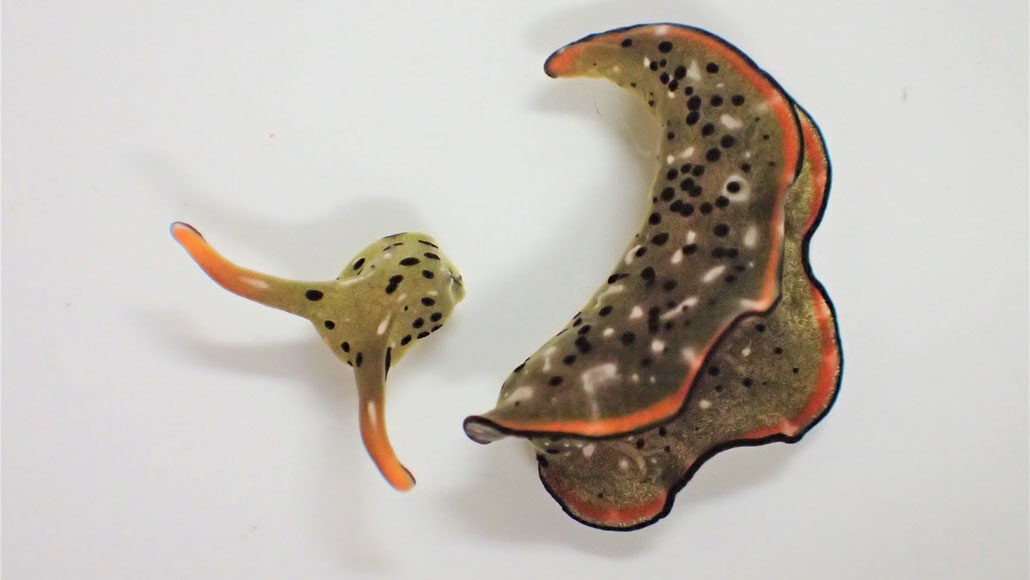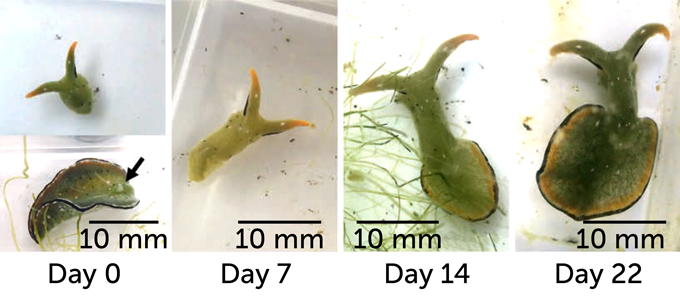A sea slug’s head can crawl around and grow a whole new body
Some may disconnect a parasite-infested body, then grow a new clean one

The detached head of a sea slug (Elysia cf. marginata) glides by its still-living, leaf-shaped body a day after separation. That body, around 80 percent of the animal’s weight, is out of luck. It’s the head that survives, growing a new body.
S. Mitoh
By Susan Milius
Losing your body from the neck down can be just another of life’s annoying — if temporary — setbacks. That is, if you’re one of two kinds of rippling, green-tinged sea slugs.
Heads of Elysia cf. marginata sea slugs sometimes pull themselves free from their bodies. The heads just keep crawling around. Within a few hours, some heads start nibbling algae again. Within about 20 days, heads from young slugs can have regrown those missing body parts, heart and all.
Sayaka Mitoh and Yoichi Yusa are ecologists at Nara Women’s University in Japan. They described the regrowth of slug bodies March 8 in Current Biology.

“As far as we know,” Yusa says, this is the first report of such a dramatic “whole-body” regeneration in any sea slug.
Other creatures can regenerate, too. Planarians are cross-eyed flatworms that biology students used to cut into pieces to study regeneration. In one way, the flatworms “are better” than a sea slug, Yusa says. They can regenerate a whole body from just a piece. Flatworms have a simple body though, lacking a heart. Likewise, sea stars can regrow a whole body from just one arm. A sea star body also lacks a central, pumping heart.
There are vertebrate regenerators, but they’re more limited. Salamanders, for instance, can regrow a tail left behind when a predator attacks. But they don’t regrow a whole body from a severed head.
Mitoh first noticed the sea slugs’ extreme regeneration by chance. It showed up in some Elysia slugs in his lab. “We were really surprised to see the head crawling,” Yusa says.
Just which Elysia species can turn into crawling heads isn’t clear yet, says Sónia Cruz. She is a marine biologist at the University of Aveiro in Portugal. She works with two other Elysia species but hasn’t seen heads leaving bodies. She does caution, however, that she has done no systematic tests on them.
Dealing with parasites
The head of a sea slug can take several hours to rip itself loose from its body. That’s so slow that Mitoh and Yusa don’t think the move helps slugs escape predators.
Instead, a detachable body could give the sea slug a drastic, but effective, way of fighting parasites. A bit like dogs getting fleas, sea slugs can be plagued by copepods. Copepods are tiny cousins of crabs and shrimp. Life styles vary, but some copepods attach themselves to sea slugs.
Mitoh monitored 82 E. atroviridis slugs infested with copepods. Three of the slugs ditched their bodies along with a lot of those copepods. Two of the three managed to grow a new body. Another 39 of the parasitized slugs let parts of their bodies slowly fall away. In contrast, another 64 sea slugs that had been collected at the same time had no pests. And none of them threw away its body. That supports the idea that parasites could drive slug heads to detach and crawl away from their bodies.
In other sea slugs, scientists already know that Arthurius copepods take over the sexual tissues, says Bernard Picton. He’s a marine zoologist. He works at National Museums North Ireland in Holywood. Parasites in sexual tissues often mean sea slugs will have far fewer offspring than normal. Evolution could have favored this body-ditching strategy as one way to get rid of a parasitized body and start over.
That may not be as hard as it sounds. Mitoh and Yusa found a slight groove behind the back of the sea slug’s head. That groove seems to work as a break-here zone. The bodies left behind can still move on their own for days. An abandoned body, however, doesn’t regrow its head. The leaf-shaped leftover body eventually dies.
What might help Elysia slug heads regrow a whole body is stealing, Yusa suggests. These animals can take the green sunlight-trapping energy factories called chloroplasts from algae. Very young slugs don’t have any chloroplasts. “They need to pierce the cell walls of sea algae and sip the contents,” he says. Once ingested, the chloroplasts remain alive inside the slugs for weeks to months.
Biologists have debated what stealing chloroplasts does for the slugs. Yusa has linked the looted chloroplasts to such key matters as better reproduction. If slugs get extra energy from chloroplasts, that boost might be just what a severed head needs to get (more than) ahead.